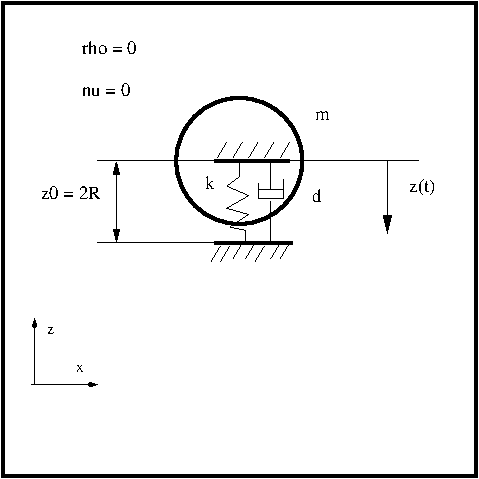Difference between revisions of "1Dof spring mass damper system by Michael Alletto"
| Line 27: | Line 27: | ||
===Mesh generation=== | ===Mesh generation=== | ||
| + | |||
| + | In this tutorial we will compare the results of two solvers: overPimpleDyMFoam and pimpleFoam. The first solver uses the overset method to account for the displacement of the solid body and the second one the morphing mesh method. The reason we chose to compare this two solvers even if we are only interested in the solid body motion solver a twofold: The first one is for consistency. Since in the previous tutorial (see [https://wiki.openfoam.com/Inline_oscillating_cylinder_by_Michael_Alletto]) we compared this two solvers and in a follow up tutorial we will do the same, it is consistent to do the same here. This tutorials belong to a series which aim to verify the capability of OpenFOAM to simulate vortex induced vibrations on circular cylinders. The second reason is that the solver overPimpleDyMFoam does not allow to update the spring and damper force during the outer iteration of the pimple loop. We will see that this leads to an unstable numerical method for the undamped spring-mass system if the Newmark method is used. The meshes generation is taken from the tutorial | ||
| + | [https://wiki.openfoam.com/Inline_oscillating_cylinder_by_Michael_Alletto] and are shown in the below figures: | ||
===Simulation set up=== | ===Simulation set up=== | ||
Revision as of 10:35, 14 July 2020
- contributor: Michael Alletto
- affiliation: WRD MS
- contact: click here for email address
- OpenFOAM versions: v2006
- Published under: CC BY-NC-ND license (creative commons licenses)
Go back to Collection by authors.
Go back to Meshing.
Contents
Introduction
Fluid structure interaction is associated with a multitude of physical phenomena: the stability and response of aircraft wings, the flow through arteries, the vibration of heat exchanger, the vibration of compressor and turbine blades and many more [1]. In order to capture this phenomena accurately, it is important to sorrowfully validate both fluid and structure solvers first separately and after that both together. In this spirit, in this small tutorial we show a small validation case of the six degree of freedom solver of OpenFOAM. This solver is responsible to advance the location of a rigid body subject to fluid forces and restrains like springs and damper in time.
Set up
The next figure shows the setup of the simulation: We have a closed square with a fluid initially at rest. Actually the fluid part does not play a role in this tutorial since we are interested only in the movement of the one degree of freedom spring-mass-damper system. In order to exclude any influence of the fluid force on the movement of the circular cylinder we set the density ρ and the viscosity ν to zero (actually to a very small value to avoid possible divisions by zero). In this way the pressure force which acts normal to the solid body surface and the shear stress which acts parallel to it do not influence the motion of the cylinder.
The mass m is set to m = 0.03575 kg, the spring constant k of the linear spring is set to k = 69.48 N/m. Two different damping cases are considered. The first one is an undamped system. In the second case the damping constant d is set to d = 0.0039 Ns/m which corresponds to a weakly damped system. For undamped and weakly damped systems the oscillation induced by the fluid on the structure can have potentially disastrous effects. The spring has an initial extension of z0 = 0.0016 m which corresponds to the diameter of the cylinder.
For this configuration we have an analytical solution which we can use to verify our solver:
z/z0 = exp(-0.5(d/m)t)cos((k/m)0.5t)
Mesh generation
In this tutorial we will compare the results of two solvers: overPimpleDyMFoam and pimpleFoam. The first solver uses the overset method to account for the displacement of the solid body and the second one the morphing mesh method. The reason we chose to compare this two solvers even if we are only interested in the solid body motion solver a twofold: The first one is for consistency. Since in the previous tutorial (see [1]) we compared this two solvers and in a follow up tutorial we will do the same, it is consistent to do the same here. This tutorials belong to a series which aim to verify the capability of OpenFOAM to simulate vortex induced vibrations on circular cylinders. The second reason is that the solver overPimpleDyMFoam does not allow to update the spring and damper force during the outer iteration of the pimple loop. We will see that this leads to an unstable numerical method for the undamped spring-mass system if the Newmark method is used. The meshes generation is taken from the tutorial [2] and are shown in the below figures:
Simulation set up
Results
Lessons learned
References
[1] Earl H Dowell and Kenneth C Hall. Modeling of fluid-structure interaction. Annual review of fluid mechanics, 33(1):445–490, 2001.
